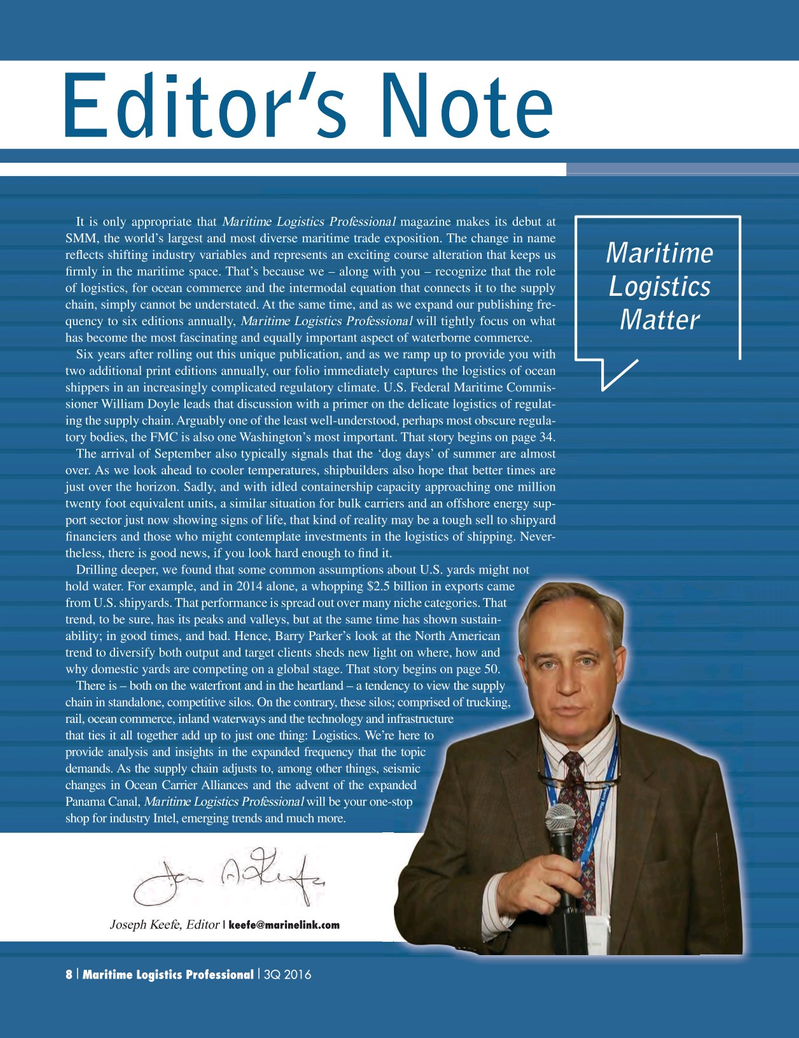
Page 8: of Maritime Logistics Professional Magazine (Q3 2016)
Shipbuilding, Repair & Maintenance
Read this page in Pdf, Flash or Html5 edition of Q3 2016 Maritime Logistics Professional Magazine
Editor’s Note
It is only appropriate that Maritime Logistics Professional magazine makes its debut at
SMM, the world’s largest and most diverse maritime trade exposition. The change in name re? ects shifting industry variables and represents an exciting course alteration that keeps us
Maritime ? rmly in the maritime space. That’s because we – along with you – recognize that the role of logistics, for ocean commerce and the intermodal equation that connects it to the supply
Logistics chain, simply cannot be understated. At the same time, and as we expand our publishing fre- quency to six editions annually, Maritime Logistics Professional will tightly focus on what
Matter has become the most fascinating and equally important aspect of waterborne commerce.
Six years after rolling out this unique publication, and as we ramp up to provide you with two additional print editions annually, our folio immediately captures the logistics of ocean shippers in an increasingly complicated regulatory climate. U.S. Federal Maritime Commis- sioner William Doyle leads that discussion with a primer on the delicate logistics of regulat- ing the supply chain. Arguably one of the least well-understood, perhaps most obscure regula- tory bodies, the FMC is also one Washington’s most important. That story begins on page 34.
The arrival of September also typically signals that the ‘dog days’ of summer are almost over. As we look ahead to cooler temperatures, shipbuilders also hope that better times are just over the horizon. Sadly, and with idled containership capacity approaching one million twenty foot equivalent units, a similar situation for bulk carriers and an offshore energy sup- port sector just now showing signs of life, that kind of reality may be a tough sell to shipyard ? nanciers and those who might contemplate investments in the logistics of shipping. Never- theless, there is good news, if you look hard enough to ? nd it.
Drilling deeper, we found that some common assumptions about U.S. yards might not s about U.S. yards might not hold water. For example, and in 2014 alone, a whopping $2.5 billion in exports came 5 billion in exports came billion in exports came from U.S. shipyards. That performance is spread out over many niche categories. That ny niche categories. That trend, to be sure, has its peaks and valleys, but at the same time has shown sustain-me e has shown sustain- at h N h A i ability; in good times, and bad. Hence, Barry Parker’s look at the North American the North American trend to diversify both output and target clients sheds new light on where, how and ght t on where, how and why domestic yards are competing on a global stage. That story begins on page 50.ory y begins on page 50.
den ncy to view the supply There is – both on the waterfront and in the heartland – a tendency to view the supply chain in standalone, competitive silos. On the contrary, these silos; comprised of trucking, os; ; comprised of trucking, d in nfrastructure rail, ocean commerce, inland waterways and the technology and infrastructure that ties it all together add up to just one thing: Logistics. We’re here to ’re e here to the e topic provide analysis and insights in the expanded frequency that the topic demands. As the supply chain adjusts to, among other things, seismic sei ismic changes in Ocean Carrier Alliances and the advent of the expanded pan nded
Panama Canal, Maritime Logistics Professional will be your one-stop e-s stop shop for industry Intel, emerging trends and much more.
Joseph Keefe, Editor | [email protected] 8 Maritime Logistics Professional 3Q 2016I I 1-17 Q3 MP2016.indd 8 8/17/2016 11:43:20 AM

 7
7

 9
9
